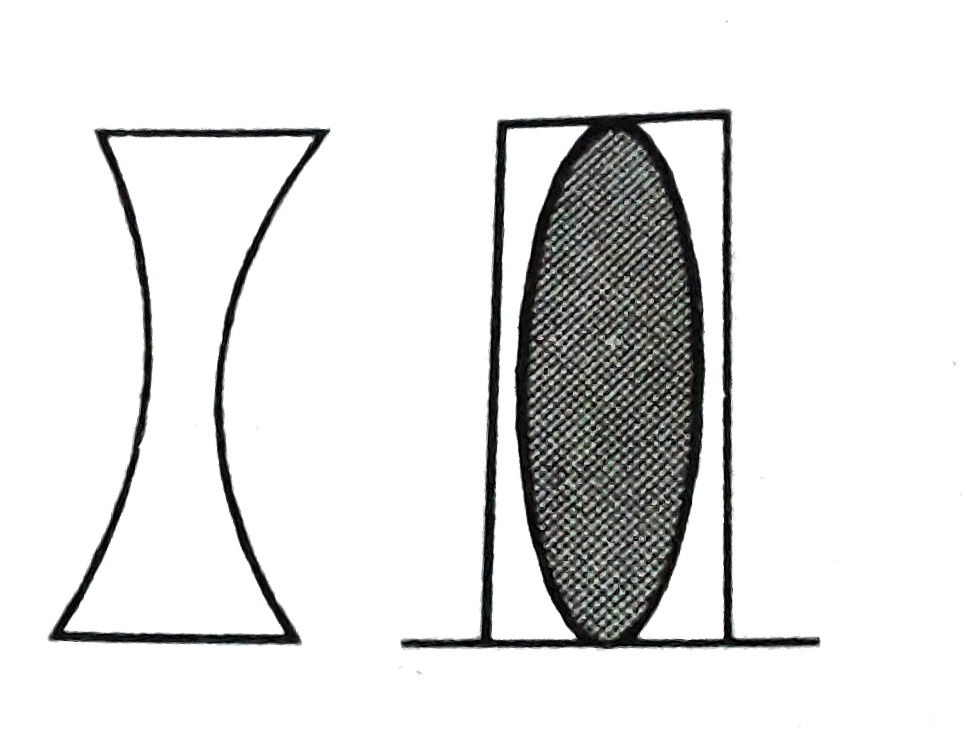The focal length of a convex lens of R.I.1.5 is f when it is placed in air. When it is immersed in a liquid is behaves as a converging lens its focal length becomes xf(x>1). The refractive index of the liquid
>3/2
<(3/2) and <1
<3/2
All of these
The correct Answer is:B
To solve the problem, we will use the lens maker's formula, which relates the focal length of a lens to its refractive index and the radii of curvature of its surfaces.
1. Understanding the Lens Maker's Formula:
The lens maker's formula is given by:
1f=(μ1−μ2)(1R1−1R2)
where:
- f is the focal length of the lens,
- μ1 is the refractive index of the lens material,
- μ2 is the refractive index of the medium in which the lens is placed,
- R1 and R2 are the radii of curvature of the lens surfaces.
2. Focal Length in Air:
When the lens is in air, we have:
- μ1=1.5 (refractive index of the lens),
- μ2=1 (refractive index of air).
Thus, the equation becomes:
1f=(1.5−1)(1R1−1R2)=0.5(1R1−1R2)
3. Focal Length in Liquid:
When the lens is immersed in a liquid, we denote the refractive index of the liquid as n. The lens behaves as a converging lens, and its focal length becomes xf (where x>1). The formula now becomes:
1xf=(1.5−n)(1R1−1R2)
4. Setting Up the Equations:
From the two scenarios, we can set up the following equations:
- From air:
1f=0.5(1R1−1R2)(1)
- From liquid:
1xf=(1.5−n)(1R1−1R2)(2)
5. Dividing the Equations:
Dividing equation (2) by equation (1):
1/xf1/f=(1.5−n)0.5
This simplifies to:
1x=(1.5−n)0.5
Rearranging gives:
1.5−n=0.5⋅1x
Thus:
n=1.5−0.5x
6. Finding the Refractive Index:
Since x>1, the term 0.5x<0.5. Therefore:
n<1.5+0.5=2
Also, since n must be greater than 1 (as it is a liquid), we have:
1<n<2
7. Conclusion:
The refractive index of the liquid is:
n<32andn>1
Final Answer:
The refractive index of the liquid is n such that 1<n<32.
The lens maker's formula is given by:
1f=(μ1−μ2)(1R1−1R2)
where:
- f is the focal length of the lens,
- μ1 is the refractive index of the lens material,
- μ2 is the refractive index of the medium in which the lens is placed,
- R1 and R2 are the radii of curvature of the lens surfaces.
When the lens is in air, we have:
- μ1=1.5 (refractive index of the lens),
- μ2=1 (refractive index of air).
Thus, the equation becomes:
1f=(1.5−1)(1R1−1R2)=0.5(1R1−1R2)
When the lens is immersed in a liquid, we denote the refractive index of the liquid as n. The lens behaves as a converging lens, and its focal length becomes xf (where x>1). The formula now becomes:
1xf=(1.5−n)(1R1−1R2)
From the two scenarios, we can set up the following equations:
- From air:
1f=0.5(1R1−1R2)(1)
- From liquid:
1xf=(1.5−n)(1R1−1R2)(2)
Dividing equation (2) by equation (1):
1/xf1/f=(1.5−n)0.5
This simplifies to:
1x=(1.5−n)0.5
Rearranging gives:
1.5−n=0.5⋅1x
Thus:
n=1.5−0.5x
Since x>1, the term 0.5x<0.5. Therefore:
n<1.5+0.5=2
Also, since n must be greater than 1 (as it is a liquid), we have:
1<n<2
The refractive index of the liquid is:
n<32andn>1
The refractive index of the liquid is n such that 1<n<32.
Topper's Solved these Questions
- RAY OPTICS AND WAVE OPTICS BOOK - VMC MODULES ENGLISHCHAPTER - RAY OPTICS AND WAVE OPTICS EXERCISE - IMPECCABLE
58 Videos
- RAY OPTICS AND WAVE OPTICS BOOK - VMC MODULES ENGLISHCHAPTER - RAY OPTICS AND WAVE OPTICS EXERCISE - ENABLE
50 Videos
- RAY OPTICS BOOK - VMC MODULES ENGLISHCHAPTER - RAY OPTICS EXERCISE - IN-CHAPTER EXERCISE-J
10 Videos
- REVISION TEST-15 JEE - 2020BOOK - VMC MODULES ENGLISHCHAPTER - REVISION TEST-15 JEE - 2020EXERCISE - PHYSICS
25 Videos
Similar Questions
Focal length of a convex lens of refractive index 1.5 is 2 cm. Focal length of lens when immersed in a liquid of refractive index 1.25 will be
View SolutionAn equiconcave diverging lens of focal length F is cut into two equal halves. The two halves are turned around and joined with some liquid between them.The lens obtained is converging with focal length F. If the refractive index of the liquid is 3 then what is the refractive index of the lens?

View SolutionA double convex lens of focal length 30 cm is made of glass. When it is immersed in a liquid of refractive index 1.4, the focal length is found to be 126 cm. The critical angle between glass and the liquid is
View SolutionA lens is made of flint glass (refractive index =1.5). When the lens is immersed in a liquid of refractive index 1.25 , the focal length:
View SolutionA thin equi-convex lens is made of glass of refractive index 1.5 and its length is 0.2m. If it acts as a concave lens of 0.5m focal length when dipped in a liquid, the refractive index of the liquid is
View SolutionThe focal length of lens of refractive index 1.5 in air is 30cm When it is immersed in water of refractive index 43 ,then its focal length will be
View SolutionA thin convex lens of refractive index 1.5cm has 20cm focal length in air. If the lens in completely immersed in a liquid of refractive index. 1.6, then its focal length will be
View SolutionA thin lens (μ=1.5) of focal length + 12 cm is immersed in water (μ=1.33). What is its new focal length ?
View SolutionA thin lens of refractive index 1.5 has focal length of 15cm in air. When the lens is placed is a medium of refractive index (4)/(3), its focal length will become …..cm.
View SolutionA thin convergent glass lens (μg=1.5) has a power of +5.0D. When this lens is immersed in a liquid of refractive index μ1, it acts as a divergent lens of focal length 100cm. The value of μ1 is
View Solution
